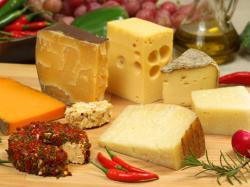Cheese Claims The Top Spot In Spending For Specialty Foods
April 3, 2012 | 2 min to read

New York, N.Y. — Surging demand for yogurt, energy bars, nut and seed butters and coffee drinks is sending the specialty food industry to new highs for the second year in a row.
U.S. retail and foodservice sales of specialty foods and beverages rose 6.9 percent in 2011, topping $75 billion, according to new research from the National Association for the Specialty Food Trade.
"Consumers are making better food a part of their lifestyle," says Ron Tanner, Vice President, Communications and Education, for the NASFT. "They are embracing new foods and flavors and are willing to choose top-quality even while they economize elsewhere."
Cheese claims the top spot in spending for specialty foods, with $3.44 billion in retail sales in 2011. The next largest retail sales categories are meats, poultry and seafood; chips, pretzels and snacks; coffee, coffee substitutes and cocoa; and bread and baked goods. Functional beverages are the fastest growing segment, followed by yogurt and kefir.
Behind the robust numbers, manufacturers, importers, brokers, distributors and retailers interviewed for the study are talking about growth opportunities for specialty food and the challenges they face. Cash flow, rising expenses for raw materials and energy, and increasing competition are top concerns.
In 2011, product introductions took a back seat, with a 6.2 percent drop as manufacturers focused on existing lines. Nevertheless, there is clearly positive momentum for the industry as the average transaction size for specialty food stores jumped 11.4 percent to $41.49.
These findings are presented in The State of the Specialty Food Industry 2012, an annual report from the NASFT prepared in conjunction with market researchers Mintel International and SPINS. The report tracks sales of specialty food through supermarkets, natural food stores and specialty food retailers.
Here are some highlights from the report:
• Specialty foods represent 13.7 percent of all food sales at retail.
• Kosher is the leading claim for new specialty food products, followed by All Natural.
• Natural food stores are the fastest growing retail channel, with a sales increase of 19.8 percent from 2009 – 2011.
• In 2011, 41 percent of specialty food manufacturers reported a sales increase of more than 20 percent.
• Local is the most influential product claim today, according to three quarters of retailers surveyed and two thirds say the claim will grow the most in the next three years.
• Latin is the fastest emerging cuisine, retailers say. Importers report growth in cuisines from Eastern Europe and India.
A detailed summary of the research is published in the April issue of Specialty Food Magazine. A digital version will be available April 2 at specialtyfoodmagazine.com. On Wednesday, April 11 at 2 p.m. ET, NASFT will present a one-hour webinar that will delve into the data in this year's report.
About the NASFT
The NASFT is celebrating its 60th anniversary. It is a not-for-profit trade association established in 1952 to foster commerce and interest in the specialty food industry. Today there are more than 2,900 members in the U.S. and abroad. The NASFT's website for consumers, foodspring.com, provides an insider's look at specialty foods and the companies, food entrepreneurs and artisans behind them. For more information on the NASFT and its Fancy Food Shows, go to specialtyfood.com.
Source: National Association for the Specialty Food Trade
